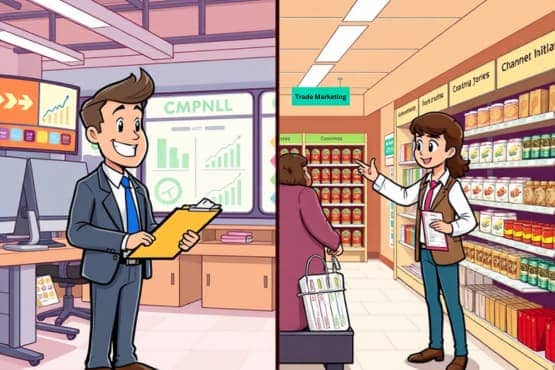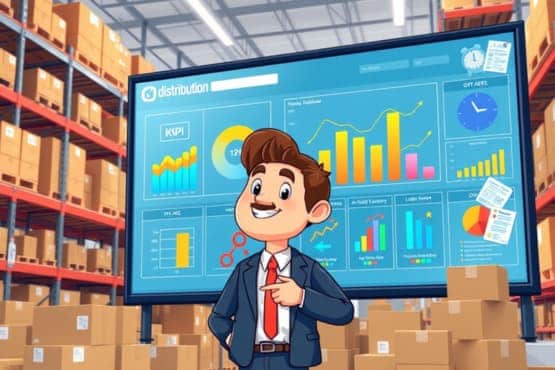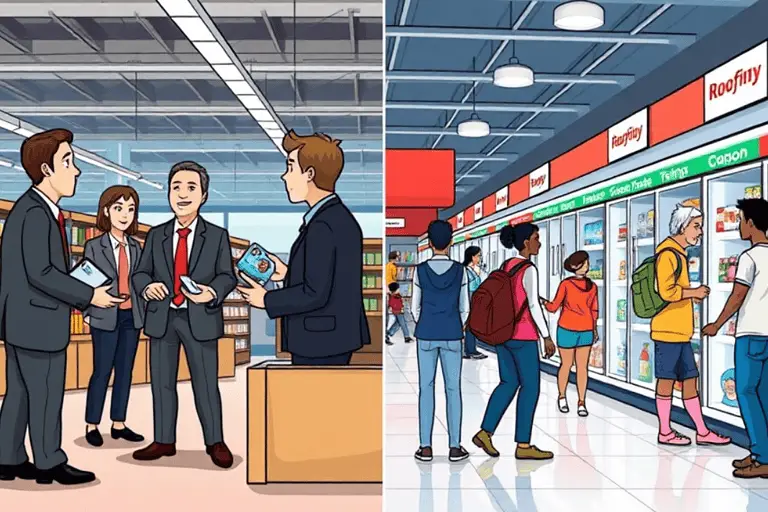In modern marketing, distribution strategies determine how efficiently a product moves through the supply chain to reach end customers. This efficiency can make or break a company’s success in today’s competitive landscape. A crucial aspect of this success lies in balancing two complementary approaches: channel marketing and trade marketing. When harmonized effectively, these strategies create a powerful synergy that can significantly boost your distribution network’s performance.
Think of distribution as the bridge between your company and your customers. A well-built bridge can handle more traffic, withstand storms, and get people to their destinations faster. Similarly, a robust distribution strategy can help your products reach more customers, weather market fluctuations, and arrive on shelves quicker.
Two key players in this distribution game are channel marketing and trade marketing. While they might sound similar, they each have unique roles in supporting your distribution network.
Let’s dive in and explore how these strategies can turbocharge your distribution success when used in tandem.
Key Takeaways
- Channel marketing engages distribution partners, while trade marketing targets retailers directly.
- Both strategies play crucial roles in optimizing distribution networks
- Successful implementation can lead to cost savings of up to 15% and improve customer satisfaction by 20%
- Digital tools and data analytics are reshaping traditional distribution models, boosting efficiency by 25%
- Sustainability is becoming a critical factor in modern distribution strategies, reducing costs and appealing to eco-conscious consumers
Understanding Channel Marketing
Definition and Objectives
Channel marketing is like being the conductor of an orchestra. Instead of musicians, you coordinate a network of distributors, wholesalers, and retailers. Your goal? To ensure your product reaches customers smoothly and efficiently.
This strategy focuses on nurturing relationships with these middlemen, or “channel partners.” Supporting and motivating these partners indirectly boost your product’s journey to the end consumer.

Key Components and Stakeholders
In the channel marketing world, you’re dealing with a cast of characters:
- Manufacturers: The creators of the product
- Distributors: The middlemen who buy in bulk and sell to retailers
- Retailers: The final stop before the product reaches consumers
Each plays a crucial role in the distribution network. Channel marketing aims to keep this entire chain running like a well-oiled machine, optimizing inventory turnover and reducing lead times.
Successful Channel Marketing Examples
Let’s look at a real-world example. Vodafone faced challenges managing complex distribution routes in emerging markets.
By implementing a comprehensive distribution management system, they gained end-to-end visibility over inventory and shipments. This led to reduced costs, improved product accessibility, and shorter time-to-market.
Another success story is Microsoft’s Cloud Solution Provider (CSP) program. By empowering its partners to sell cloud solutions, Microsoft has significantly expanded its reach in the cloud services market, improving supply chain agility and reducing stockouts.
Understanding Trade Marketing
Definition and Objectives
If channel marketing is like conducting an orchestra, trade marketing is more like being a star quarterback. Your focus is on the final play – getting your product from the retailer’s shelf into the customer’s shopping cart.
Trade marketing targets retailers directly. The goal is to make your product stand out in a sea of options, encouraging retailers to stock, display, and promote your items effectively, ultimately improving last-mile logistics.

Key Components and Stakeholders
The key players in trade marketing include:
- Suppliers: The companies providing the products
- Retailers: The businesses selling directly to consumers
- Field teams: The boots on the ground, ensuring proper product placement and promotion
Trade marketing creates win-win situations for suppliers and retailers, optimizing shelf space and improving inventory management.
Successful Trade Marketing Examples
Nestlé faced challenges managing numerous small retailers in areas with poor infrastructure. They implemented a distribution management system to gain insights into routes and control inventory.
The outcome? Better product availability, fewer stock-outs, and streamlined supply chains led to significant cost savings and improved market responsiveness.
Procter & Gamble’s (P&G) shelf-ready packaging initiative is another success story. By designing packaging that could go directly from truck to shelf, P&G made it easier and more efficient for retailers to stock their products, improving both distribution efficiency and retailer relationships.
Channel vs Trade: Key Differences
Target Audience Comparison
Channel marketing casts a wide net, focusing on the entire distribution chain. It’s like hosting a big family dinner – trying to keep everyone happy and working together.
Trade marketing, on the other hand, is more like a one-on-one date with the retailer. It’s focused and aims to create a robust, direct relationship.
Objectives and Goals
Channel marketing aims to optimize the entire distribution network. It’s about improving efficiency, expanding reach, and ensuring consistent brand representation across all channels. This can lead to reduced lead times and optimized inventory turnover.
Trade marketing has a narrower focus: maximizing sales at the retail level. It’s concerned with product placement, in-store promotions, and making your product the star of the show on retail shelves. This approach can improve product availability and speed to market.

Communication Strategies and Tactics
Channel marketing often involves broad communication strategies. Think partner newsletters, training programs, and channel-wide incentives. It’s about creating a sense of community and shared purpose among your distribution partners, which can enhance overall supply chain agility.
Trade marketing communication is more targeted. It might involve joint business planning with specific retailers, customized promotional materials, or exclusive product launches. The aim is to speak directly to each retailer’s unique needs and customer base, potentially improving inventory management and reducing stockouts.
Strategies for Optimization
Best Practices for Channel Marketing

- Develop a strong partner program: Offer your channel partners training, resources, and support. This helps them sell your product more effectively and can reduce distribution costs by up to 10%.
- Use technology to your advantage: Implement partner relationship management (PRM) software to streamline communication and track performance. This can improve distribution efficiency by 15-20%.
- Align incentives: Create reward programs that encourage partners to prioritize your products, potentially boosting sales through these channels by 25%.
- Provide marketing support: Offer co-branded marketing materials and campaigns to help partners promote your products, improving brand consistency across channels.
Best Practices for Trade Marketing

- Understand your retailers: Each retailer has unique needs and challenges. Tailor your approach accordingly to improve product placement and reduce stockouts.
- Create compelling in-store experiences: Use eye-catching displays and interactive demos to make your product stand out. This can increase sales at the retail level by up to 18%.
- Offer category management insights: Help retailers optimize their entire product category, not just your products. This can improve overall inventory management.
- Collaborate on promotions: Work with retailers to create joint promotional campaigns that benefit both parties, potentially boosting sales and improving supply chain efficiency.
Integrating Digital Tools for Optimization
The digital revolution has transformed distribution strategies. Here are some ways to leverage technology:
- Use AI for demand forecasting: Predict inventory needs more accurately to prevent stockouts and overstock situations. This can reduce inventory costs by up to 20%.
- Implement IoT for real-time tracking: Use sensors to monitor product conditions and location throughout the distribution process, improving overall supply chain visibility.
- Utilize data analytics: Analyze sales data to identify trends and optimize product mix for different channels and retailers. This can lead to a 15% improvement in distribution efficiency.
- Adopt cloud-based solutions: Improve collaboration and data sharing across your distribution network, enhancing overall supply chain agility.
Measuring Success: Distribution-Focused KPIs
To gauge the effectiveness of your strategies, consider these key performance indicators:

- Fill rate: The percentage of customer orders fulfilled on the first shipment
- On-time delivery: The percentage of orders delivered within the agreed timeframe
- Inventory turnover: How quickly you’re selling and replacing inventory
- Perfect order rate: Orders delivered on time, in total, and without issues
- Cost per order: The total cost associated with processing and delivering an order
Real-World Case Studies
Case Study 1: Channel Marketing Success – Cisco
Cisco’s partner program is a shining example of effective channel marketing. Cisco has created a highly efficient distribution network by providing comprehensive training, marketing support, and incentives to its over 60,000 partners.
Results:
- 80% of Cisco’s revenue comes through its channel partners
- Partners report higher satisfaction and loyalty
- Cisco maintains a leading position in the networking equipment market
- Improved supply chain agility and reduced stockouts
Case Study 2: Trade Marketing Success – Unilever
Unilever’s “Perfect Store” program is a testament to the power of trade marketing. This initiative involves collaborating closely with retailers to optimize product placement, pricing, and promotions.
Results:
- Stores implementing the program saw sales increases of up to 18%
- Improved relationships with key retailers
- Better brand visibility and customer engagement in-store
- Streamlined logistics and improved inventory management
Lessons Learned from Case Studies
- Invest in partner education and support
- Use data-driven insights to inform strategy
- Collaborate closely with retailers for mutual benefit
- Continuously innovate and adapt to changing market conditions
- Align marketing efforts across channels for consistent brand messaging and improved distribution efficiency
Emerging Trends in Marketing
E-commerce Impact on Distribution Models
The rise of e-commerce has forced companies to rethink their distribution strategies. Some key changes include:

- Direct-to-consumer (D2C) shipping: Bypassing traditional retail channels, reducing intermediary costs
- Omnichannel distribution: Integrating online and offline channels for a seamless customer experience and improved inventory management
- Dropshipping: Retailers pass customer orders directly to manufacturers for fulfilment, optimizing inventory and reducing shipping times
Data Analytics Role in Optimization
Data is the new oil in the world of distribution. Advanced analytics can help:

- Predict demand more accurately, reducing overstock and stockout situations by up to 30%
- Optimize inventory levels across the network, potentially cutting inventory costs by 20-30%
- Identify the most efficient distribution routes, reducing transportation costs by 10-15%
- Personalize marketing efforts for different channels and retailers, increasing sales effectiveness
Sustainability Considerations in Distribution
Sustainability is no longer just a buzzword; it’s becoming a key factor in distribution strategies:

- Green logistics: Using eco-friendly transportation and packaging, potentially reducing carbon footprint by 20-30%
- Circular supply chains: Implementing recycling and reuse programs, improving resource efficiency
- Local sourcing: Reducing transportation distances and supporting local economies, cutting logistics costs by 5-10%
- Ethical sourcing: Ensuring fair labour practices throughout the supply chain, enhancing brand reputation
Action Items:
- Assess your current distribution strategy. Are you leveraging both channel and trade marketing effectively?
- For B2B businesses: Focus on strengthening partner relationships and providing comprehensive support
- For retail businesses: Emphasize in-store marketing and category management
- For D2C businesses: Optimize your e-commerce platform and last-mile delivery.
- Identify key partners in your distribution network. How can you better support and motivate them?
- Implement a partner scoring system to identify top performers
- Develop tailored incentive programs for different partner tiers
- Analyze your retail presence. Are there opportunities to improve product placement or in-store marketing?
- Conduct regular store audits
- Use heat mapping technology to optimize product placement
- Evaluate your use of digital tools in distribution. Could technologies like AI or IoT help optimize your processes?
- Start with a pilot program in one area of your distribution network
- Measure the impact and ROI before scaling up
- Consider the sustainability of your distribution network. Are there areas where you could reduce environmental impact?
- Conduct a sustainability audit of your distribution network
- Set specific, measurable goals for improvement
Remember, the world of distribution is constantly evolving. Stay informed about emerging trends, be willing to adapt, and always keep your focus on creating value for your partners, retailers, and, ultimately, your customers.
As you navigate the evolving landscape of distribution strategies, consider visiting Trade Marketing Insider for a wealth of resources and insights to deepen your understanding.




